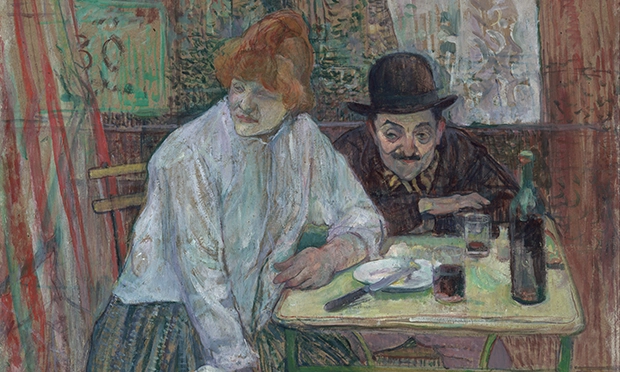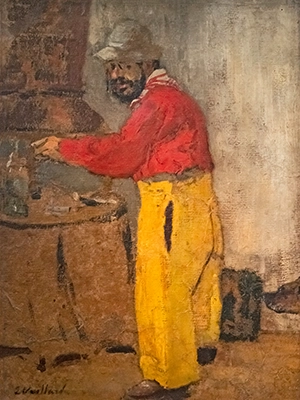‘La vie! La vie!’

At the Café La Mie by Henri de Toulouse-Lautrec
Far from the dissolute, degenerate, alcoholic rebel son of unfeeling aristocratic parents, Henri de Toulouse-Lautrec seems in perspective to have been a successful painter and popular young man about town.
He had all the skills and self-discipline of an innovative lithographic printer, when this was a new medium for avant-garde artists.
His friend Edouard Vuillard did a portrait of Lautrec enjoying himself in the kitchen (above, right), where he created wonderful meals every week for his friends, supplied by doting parents from their massive estates in the south of France.
It came as a bit of a shock, when researching a book on the Impressionists and food, to find that Toulouse-Lautrec deliberately avoided food as a topic, though drink and its effects figured in his paintings in a somewhat melancholy way.
His world of brothels, sleazy bars, and night clubs, was a deliberate choice of topic by a young painter seeking notoriety in a crowded field, and he is remembered, as he intended, for the way he evoked the fun and misery of it all.

Portrait of Toulouse-Lautrec by his great friend, Edouard Vuillard
Paris was the ideal place for this, with its sparkling new boulevards and brightly lit cafes and bars, popular theatres and night clubs, where harmless fun and dissipation were there for all, and vividy seen on the menus Lautrec designed and printed.
His wealthy parents encouraged the little boy in his enthusiasm for drawing and sketching and later painting and printmaking.
Hampered by a congenital condition and after breaking both legs in childhood, Toulouse-Lautrec seemed stunted. He used to say that if his legs had been longer, he would never have become an artist.
Sitting at his easel, height did not matter, and photographs and self-portraits show a handsome young man with a zest for life who found expression in cooking for his friends.
‘La vie! La vie!’ he chortled, brandishing a knife, as in this affectionate portrait by his friend Vuillard, astonishing guests with a sometimes bizzare choice of ingredients.
He kept notes of his recipes, in a haphazard way, and later writers have put them together in book form, as menus and recipes, so we can reconstruct these events; though not, I hope, the seriously horrible cocktails of three parts absinthe to one or two of brandy that did a lot to hasten Toulouse’s early death in 1901 aged 37.
The structure of the recipes and manus was not innovatory, although some of the items were rare or unusual – squirrel being one.
Classic French cuisine was then almost holy writ, and it was within its conventions that our Henri set out to please and astonish.
It is hard for us, today, enjoying the gastronomically varied cuisines of Hackney, to grasp the impact of his cooking and hospitality within these conventions: using pigeons instead of chicken in a coq au vin.
Lautrec also had a tame cormorant, trained to procure the finest fish, that he would often parade around coastal resorts.
Vuillard’s family cooking might have been more modest; his widowed mother brought up her children with frugality on her earnings as dressmaker and upholsterer – it’s not hard to imagine the loose covers and three-piece suits of her bourgeois clients – but she supported her son throughout his career, and her severity relaxed as she became a devoted grandmother.
Vuillard’s Children depicts a scene of young ones sat around a table, and is one of many Impressionist evocations of food; it is something Lautrec must have deliberately chosen to ignore.
